
In my view, this is the most important concern about water injected for frac’ing that is rarely reported in main media:
A proportion (25% to 100%) of the water used in hydraulic fracturing is not recovered, and consequently this water is lost permanently to re-use, which differs from some other water uses in which water can be recovered and processed for re-use.

‘Monster Fracks’ Are Getting Far Bigger. And Far Thirstier, Giant new oil and gas wells that require astonishing volumes of water to fracture bedrock are threatening America’s fragile aquifers by Hiroko Tabuchi and Blacki Migliozzi, The fourth article in a series on the causes and consequences of disappearing water, Sept. 25, 2023, The New York Times
Increasingly complex oil wells are sweeping across Texas, birthplace of the fracking revolution, and the nation. Fracking sites
A Times analysis found that these new wells can consume millions of gallons of water, often taken from dwindling aquifers. Texas aquifers
To satisfy that thirst, energy giants are drilling not just for oil, but for the water they need. Water wells that supply fracking
Nationwide, fracking has used up nearly 1.5 trillion gallons of water since 2011. That’s how much tap water the entire state of Texas uses in a year.
Along a parched stretch of La Salle County, Texas, workers last year dug some 700 feet deep into the ground, seeking freshwater. Millions of gallons of it.
The water wouldn’t supply homes or irrigate farms. It was being used by the petroleum giant BP to frack for fossil fuels. The water would be mixed with sand and toxic chemicals and pumped right back underground — forcing oil and gas from the bedrock.
It was a reminder that to strike oil in America, you need water. Plenty of it.
Today, the insatiable search for oil and gas has become the latest threat to the country’s endangered aquifers, a critical national resource that is already being drained at alarming rates by industrial farming and cities in search of drinking water.
The amount of water consumed by the oil industry, revealed in a New York Times investigation, has soared to record levels. Fracking wells have increased their water usage sevenfold since 2011 as operators have adopted new techniques to first drill downward and then horizontally for thousands of feet. The process extracts more fossil fuels but requires enormous amounts of water.
Together, oil and gas operators reported using about 1.5 trillion gallons of water since 2011, much of it from aquifers, the Times found. Fracking a single oil or gas well can now use as much as 40 million gallons of water or more.
These mega fracking projects, called “monster fracks” by researchers, have become the industry norm. They barely existed a decade ago. Now they account for almost two out of every three fracking wells in Texas, the Times analysis found.
‘Monster fracks’ take off in Texas
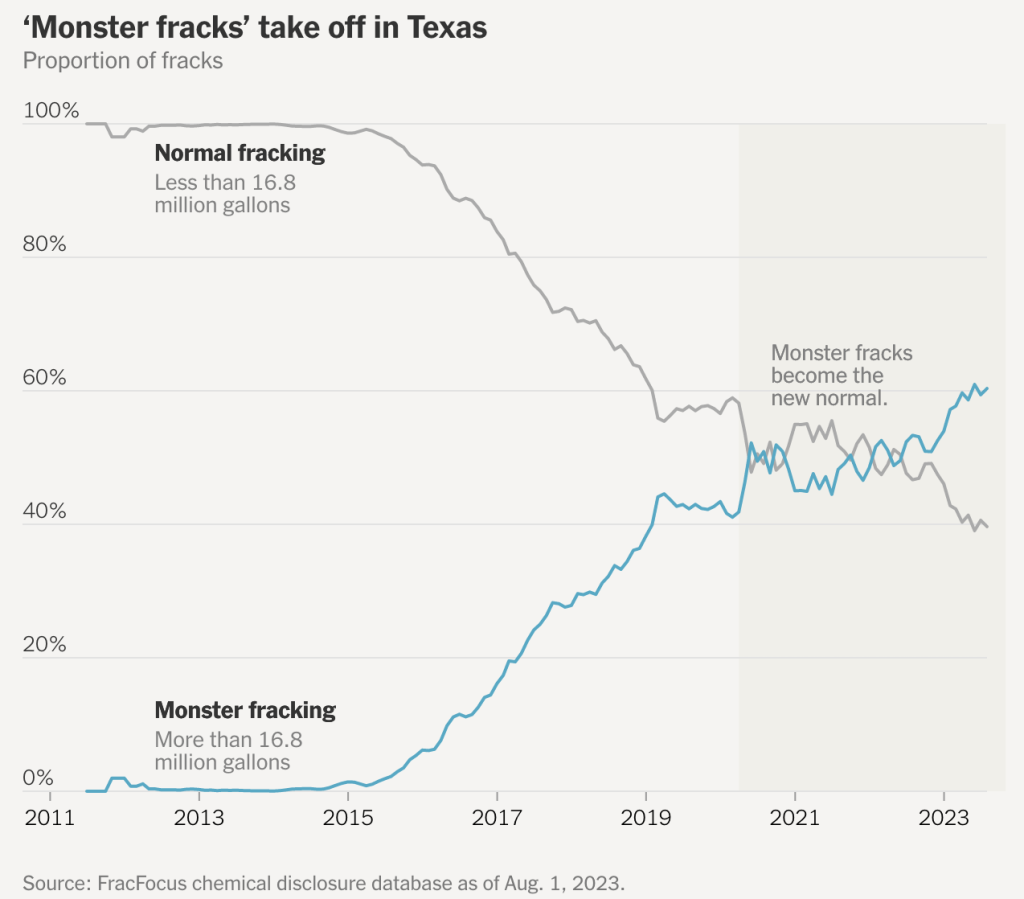
Source: FracFocus chemical disclosure database as of Aug. 1, 2023.
“They’re the newcomers, a new sector that burst onto the scene and is heavily reliant on the aquifers,” said Peter Knappett, an associate professor in hydrogeology at Texas A&M University, referring to fracking companies. “And they could be pumping for several decades from aquifers that are already over-exploited and already experiencing long-term declines.”
Fracking, which is shorthand for hydraulic fracturing, has transformed the global energy landscape, turning America into the world’s largest oil and gas producer, surpassing Saudi Arabia. Supporters say it has strengthened America’s national security and created valuable jobs.
But fracking has long been controversial. The process of cracking the bedrock by injecting chemical-laced water into the ground can lead to spills and leaks and can affect the local geology, sometimes contributing to earthquakes. Critics of fracking say it is an irony that so much water is being diverted to produce fossil fuels, given that the burning of fossil fuels is causing climate change, further straining freshwater resources.
The Times documented the surging water usage by examining an industry database in which energy companies report the chemicals they pump into the ground while fracking. But the database also includes details on their water usage, revealing the dramatic growth.
Individual fracks are using more and more water
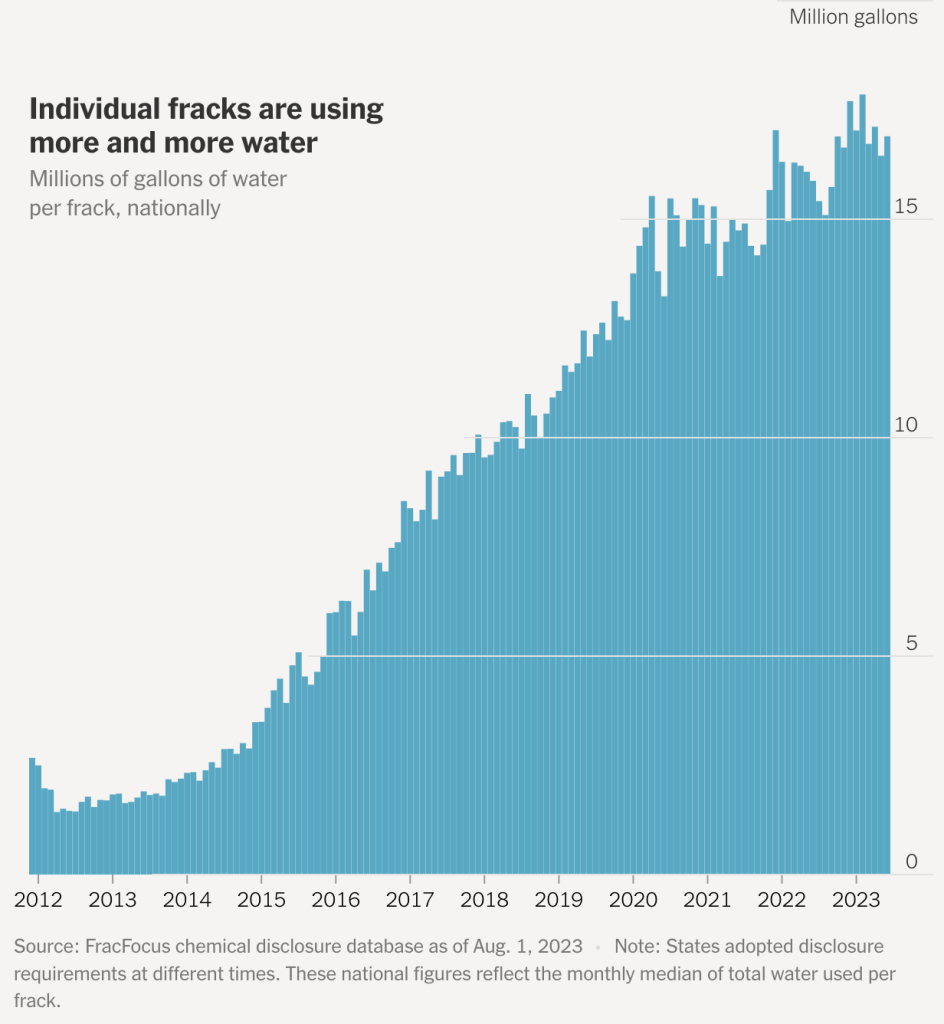
Source: FracFocus chemical disclosure database as of Aug. 1, 2023
Note: States adopted disclosure requirements at different times. These national figures reflect the monthly median of total water used per frack.
The problem is particularly acute in Texas, where the state’s groundwater supply is expected to drop one-third by 2070. As the planet warms, scientists have predicted that Texas will face higher temperatures and more frequent and intense droughts, along with a decline in groundwater recharge. Some experts have warned that water issues could even constrain oil and gas production.
In the western portion of the Eagle Ford, one of the state’s major oil-producing regions, aquifer levels have fallen by up to 58 feet a year, a 2020 study by researchers at the University of Texas at Austin found, and fracking’s water demands could result in further regional declines of up to 26 feet.
Since 2011, BP has dug at least 137 groundwater wells in Texas for its oil and gas operations and reported using 9.1 billion gallons of water nationally during the past decade. EOG, one of the country’s largest frackers, consumed more than 73 billion gallons of water for fracking at the same time. Apache Corporation, Southwestern Energy, Chevron, Ovintiv and other major operators also have intensified water usage, the Times analysis found.
Oil companies require no permits to drill their own groundwater wells and there is no consistent requirement that groundwater used for fracking be reported or monitored. As drought has gripped Texas and the surrounding region, many communities have instituted water restrictions for residents even as fracking has been allowed to continue unabated.
Pockets of public resistance are emerging. In New Mexico, a coalition of tribes and environmental groups is suing the state, saying that fracking companies are using up precious water resources and that the state has failed to protect the interests of residents. In Colorado, residents are fighting a proposed fracking project they fear would not just use up local freshwater resources, but risk contaminating a reservoir their community depends on.
Holly Hopkins, an executive at the American Petroleum Institute, an industry group, said the industry was “focused on meeting the growing demand for affordable, reliable energy while minimizing impacts on the environment.” Its members, she said, were “continuing to develop innovative methods to reuse and recycle” water used for fracking.![]() Frac’ers have been boasting about that for decades, but don’t reuse or recycle because it’s too expensive. Frac’ers are mostly about greed, and more greed; they’re not interested in protecting water needed to sustain life, conserving or protecting water makes them no money.
Frac’ers have been boasting about that for decades, but don’t reuse or recycle because it’s too expensive. Frac’ers are mostly about greed, and more greed; they’re not interested in protecting water needed to sustain life, conserving or protecting water makes them no money.![]()
In a statement, Apache said 80 percent of the water it used for fracking was either non-fresh or recycled from previous fracks. BP said it was “executing several pilot projects to recycle water” that would “minimize freshwater usage.”![]() Who believes anything Apache says but Apache?
Who believes anything Apache says but Apache?![]()
Chevron said that water was vital to its operations and that it aimed ![]() if Chevron were using water efficiently, they would say they were, not say they aimed to
if Chevron were using water efficiently, they would say they were, not say they aimed to![]() to use water efficiently and responsibly, saying that it used brackish or recycled water for fracking. Southwestern and Ovintiv did not respond to requests for comment.
to use water efficiently and responsibly, saying that it used brackish or recycled water for fracking. Southwestern and Ovintiv did not respond to requests for comment.
In La Salle County — where workers were drilling the water well last year that would supply BP — the local aquifers have already been strained by decades of pumping to feed crops and cattle. The local groundwater district, Wintergarten, estimates that fracking’s water needs could surpass those of irrigation by 2030 (though the oil industry’s notorious boom-and-bust cycles could change that).
Despite the new demand, Wintergarten has little say over the use of water for fracking.
According to its rules, when “moderate” or “severe” droughts occur, people should stop washing their cars and restaurants should refrain from serving glasses of water unless a customer asks. But only during “exceptional” droughts do the rules extend to fracking, and even then they merely discourage it.
Similarly in Laredo, a city on the Mexican border that recently imposed water restrictions, residents may water their lawns only three days a week, and only at night. Laredo, which in recent years has become fracking territory, is facing an impending water shortage: By 2040, it’s expected to exhaust the available supply of municipal water from the Rio Grande allocated to the city every year. Still, even during severe drought, fracking is excluded from city or state restrictions.
“This is Texas. If you’re using water for oil and gas, it’s considered exempt,” said Ronald T. Green, a hydrologist who advises Wintergarten. So when fracking plans collide with drought, Dr. Green said, “you just have to hope that if they’re a good, community-oriented company, they might decide not to frack that well till next year.”![]() No such thing as a good, community-oriented frac’er
No such thing as a good, community-oriented frac’er![]()
It’s happening, of course, because there is money to be made in oil. And for those with access to water, it can be easy money.
Bruce Frasier grows onions in Dimmit, one of the three counties that make up the Wintergarten water district. But he also sells groundwater to a local fracking company for 50 cents a barrel. Given the growing size of fracks, “If you’ve got the water to sell, you’re making a fortune,” Mr. Frasier said.
![]() In severe water shortage Alberta too!
In severe water shortage Alberta too!![]()
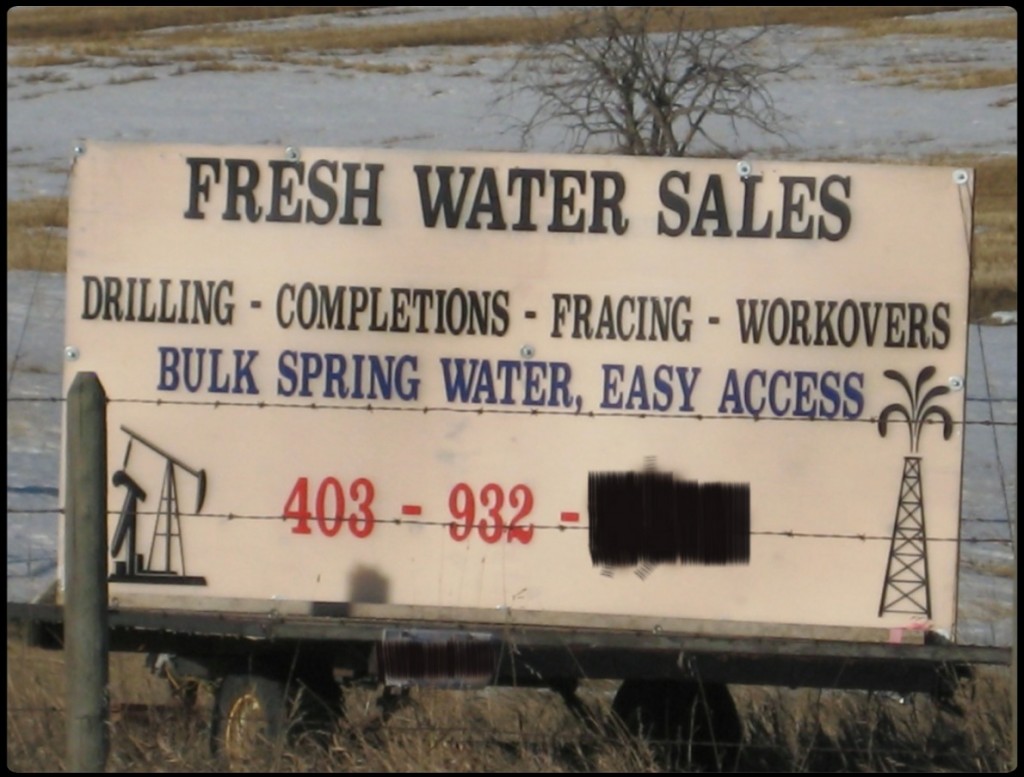
Above NW of Calgary

THE ‘HORIZONTAL’ FRACK
Wintergarten. Evergreen. Big Springs.
The place names that dot Texas’s parched plains hark back to a time more than a century ago when groundwater was plentiful.
“Back in those days, you could just dig, and the water would flow,” said Bill Martin, a rancher and farmer who heads the Wintergarten Groundwater Conservation District, as he walked his land during a recent heat wave, his boots kicking up dust under a scorching sun.
But that water, sometimes called fossil water because scientists estimate that it pooled underground as long as 30,000 years ago, started to dry up as farms irrigated vast tracts of land. Farms that couldn’t afford to drill ever deeper started to plant less or shut down.
Today, much of America’s oil and gas comes from parched land like this. And now, fracking companies are the ones scrambling for water. A 2016 Ceres report found that nearly 60 percent of the 110,000 wells fracked between 2011 and 2016 were in regions with high or extremely high water stress, including basins in Texas, Colorado, Oklahoma, and California.
This is partly because of the increasing complexity and size of fracked wells. For example one technique, horizontal drilling, involves wells that stretch thousands of feet sideways, not just downward. In the Permian Basin, average well length grew to more than 10,000 feet in the first nine months of 2022, compared with less than 4,000 feet in 2010, federal data shows.
It is because water is so fundamental to fracking that the longer wells typically require far more water.
“As the easier-to-extract areas are tapped to their full potential, you need to use more and more desperate measures,” said A.J. Kondash, an environmental scientist at RTI International, a nonprofit research organization, who has studied fracking’s water use.
The problem is actually two-fold. Fracking companies are pulling more water out of the ground, and then, after the fracking process, they must treat or dispose of millions of gallons of contaminated water, removing it from the natural water cycle.
Some companies are making strides in reusing that fracking wastewater to drill for more oil and gas, but it’s a small percentage. In the sprawling Permian Basin in Texas, the largest oil field in the country, just 15 percent of water used for fracking is recycled water, according to state estimates.
The Times based its water-use analysis on data from FracFocus, a registry of chemicals used in fracking that is operated by two national associations of state agencies, the Groundwater Protection Council and the Interstate Oil and Gas Compact Commission. In 27 states, companies report the data to FracFocus.
That data revealed surging water use even though the numbers, which are self-reported by industry, are sometimes incomplete.
Water use by major oil and gas companies Includes Encana/Ovintiv:
Includes Encana/Ovintiv:
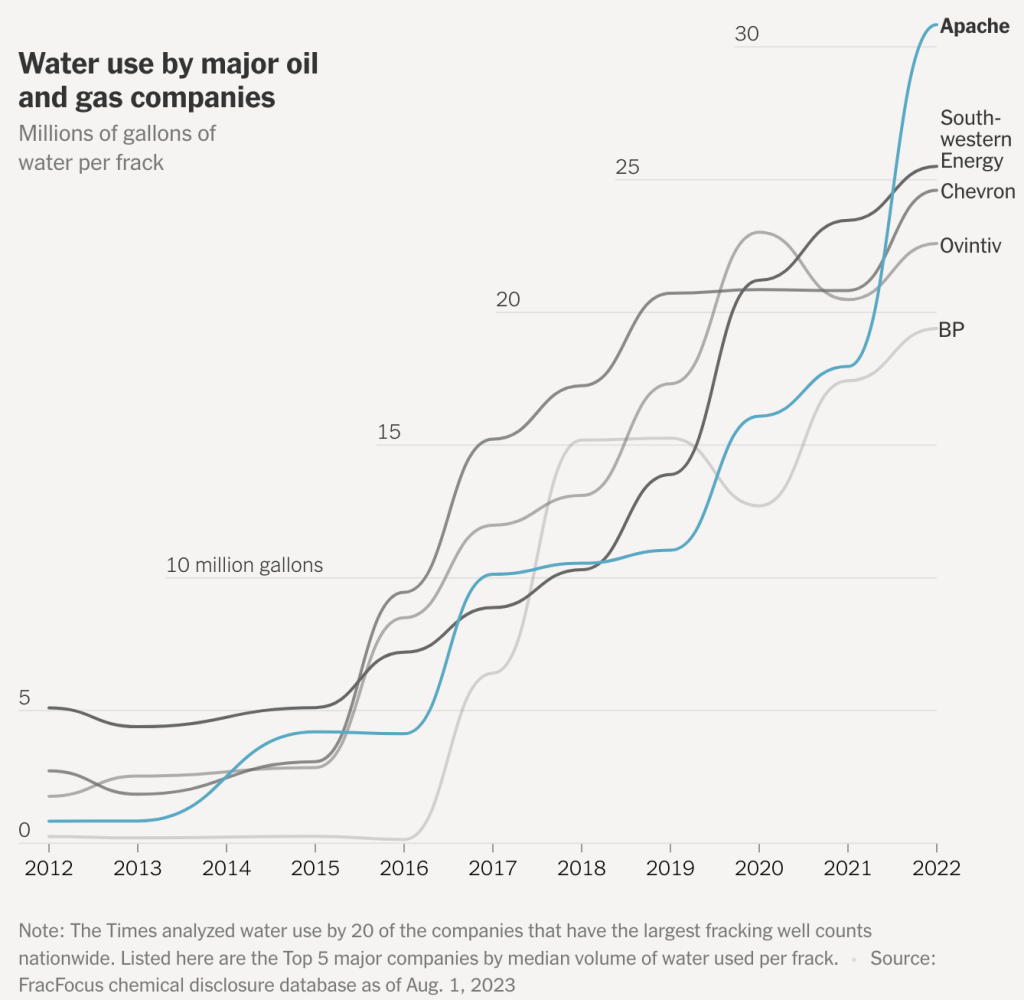
Note: The Times analyzed water use by 20 of the companies that have the largest fracking well counts nationwide. Listed here are the Top 5 major companies by median volume of water used per frack. Source: FracFocus chemical disclosure database as of Aug. 1, 2023
Dan Yates, executive director of the Groundwater Protection Council, pointed out that the two agencies that run FracFocus have no regulatory authority. The onus is on individual states, he said, to make sure operators disclose timely and accurate data.
Rystad Energy, an energy research company, estimated that about 6 to 9 percent of fracked wells don’t get reported to FracFocus.
Of course, water use by energy industries isn’t limited to fracking. Water is important in oil refining and the cooling of power plants, and also plays a role in the mining of lithium and other minerals essential in the transition to cleaner energy.
Oil companies say the industry uses substantial amounts of brackish water not suitable for drinking, though there is little systematic tracking of how much. They also say that drilling fewer, longer wells reduces environmental disruption at ground level.![]() Bullshit story. Multiwell pads are enormous, related land impacts are also enormous, the amount of radioactive waste is enormous, the air pollution, traffic impacts, all equally as enormous
Bullshit story. Multiwell pads are enormous, related land impacts are also enormous, the amount of radioactive waste is enormous, the air pollution, traffic impacts, all equally as enormous![]()
Industry groups also stress that oil and gas production uses a small fraction of the water required by other activities, like irrigated agriculture.![]() Big difference is that much if not most of the water used in frac’ing is lost forever to the hydrogeological cycle. This is not the case for household use or farm use, such as irrigation.
Big difference is that much if not most of the water used in frac’ing is lost forever to the hydrogeological cycle. This is not the case for household use or farm use, such as irrigation.![]()
But researchers at Colorado State University who compared water used for fracking in oil- and gas-producing states between 2011 and 2020 found that, under arid conditions, frackers could use more water than irrigation. In La Salle for instance, under arid conditions, fracking used more water than irrigation and local homes and businesses combined. Fracking activity, they found, responded to oil prices, and seemed largely unresponsive to droughts or water restrictions.
Compounding the problem, about a quarter of Texas operates under rules that let landowners to pump as much water on their property as they like, regardless of consequences to neighbors.
“In Texas, if you own the surface, you own everything to the center of the earth,” said Mr. Martin of the Wintergarten water district.
THE HUNT FOR WATER
The letter from an oil company arrived for Mario Atencio’s family in 2013, promising riches in exchange for a lease to drill near their home in northwestern New Mexico.
Then, Enduring Resources, the Denver-based oil and gas company that ultimately acquired the lease, started to drill.
Workers dug a water well near the area where his family raises livestock, tapping into the groundwater that had long sustained the grazing land the Atencios use to raise goats and sheep. “They came in and they put in water pipelines. Huge pools filled with water,” Mr. Atencio said. “We thought, ‘Is this our water? How much water are they tapping?’”
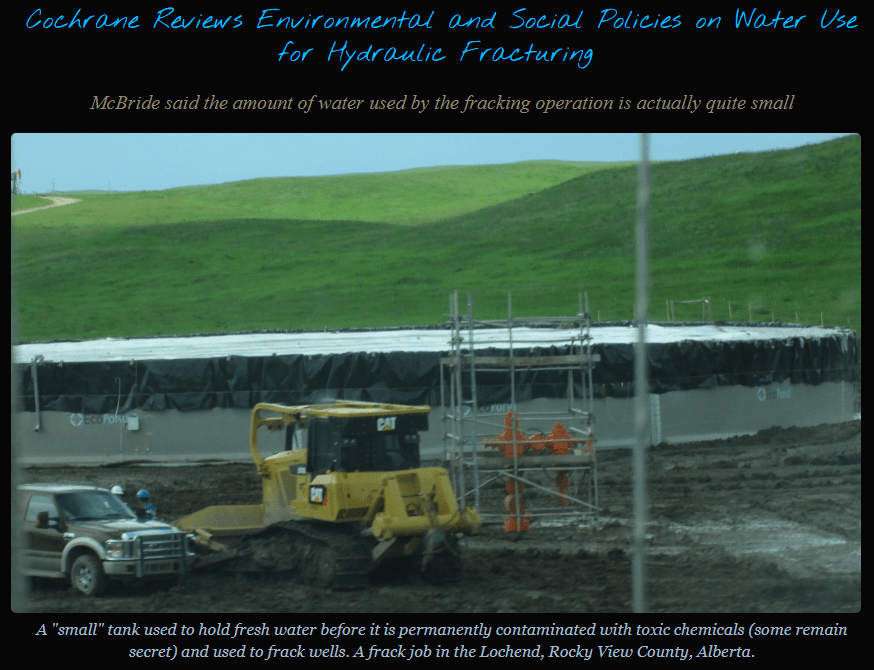
![]() Cochrane is NW of Calgary, Alberta. Snap above by FrackingCanada
Cochrane is NW of Calgary, Alberta. Snap above by FrackingCanada
Hoarding water for frac’ing is worse in northern BC and Alberta where few are looking and enforcement of laws are so lax, companies build massive illegal dams:![]()
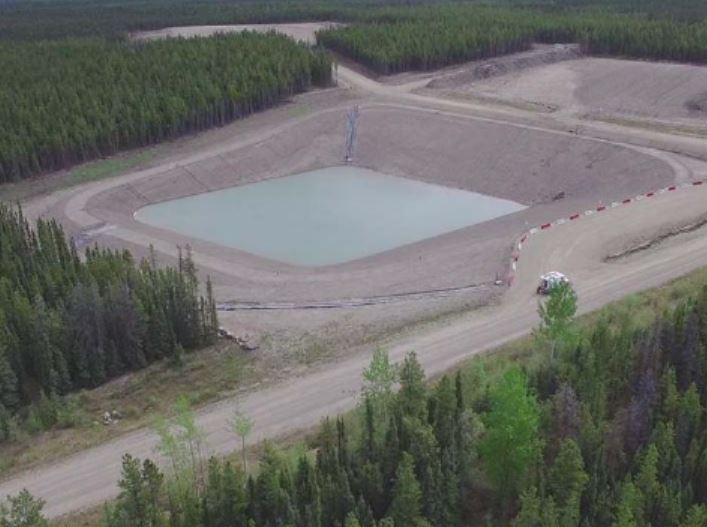
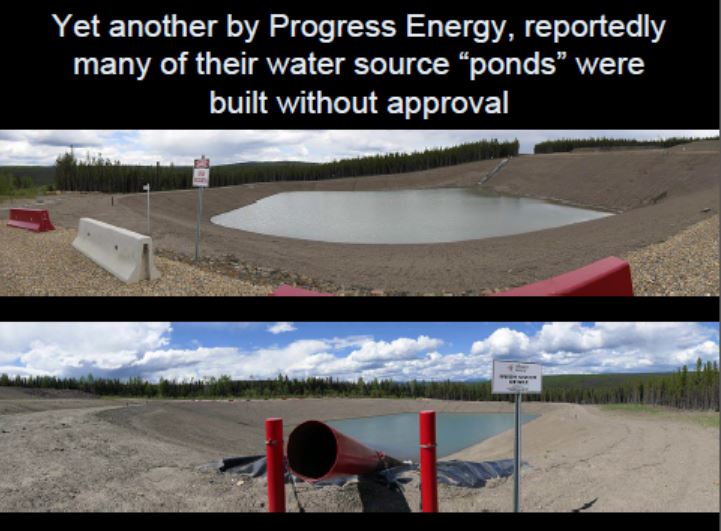
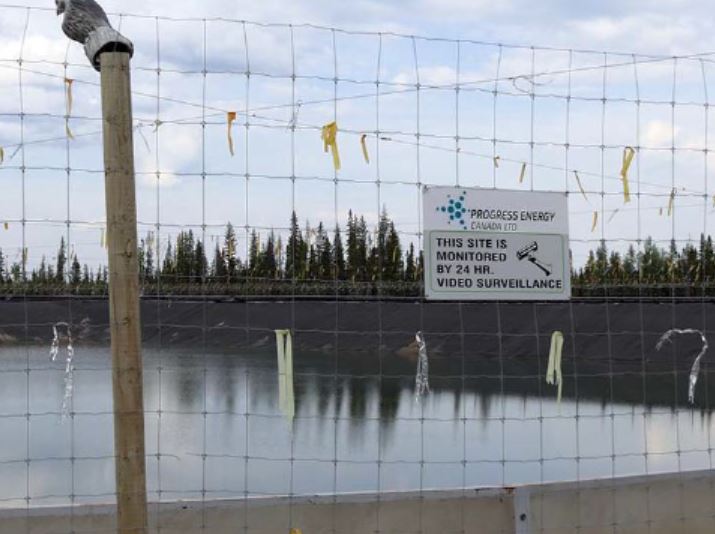

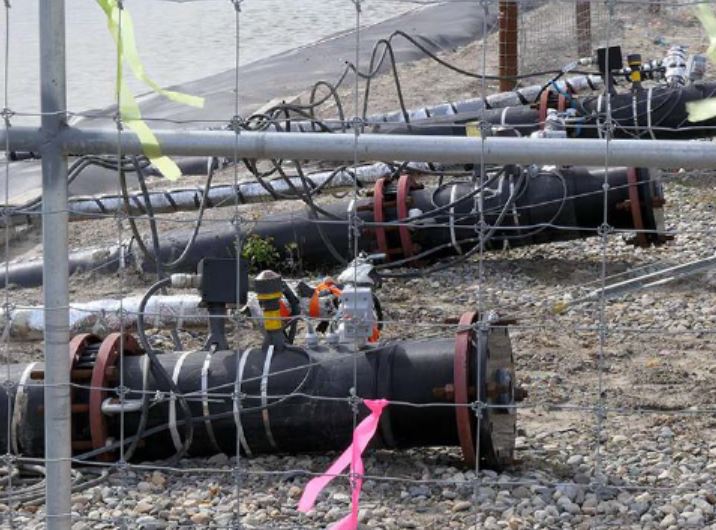
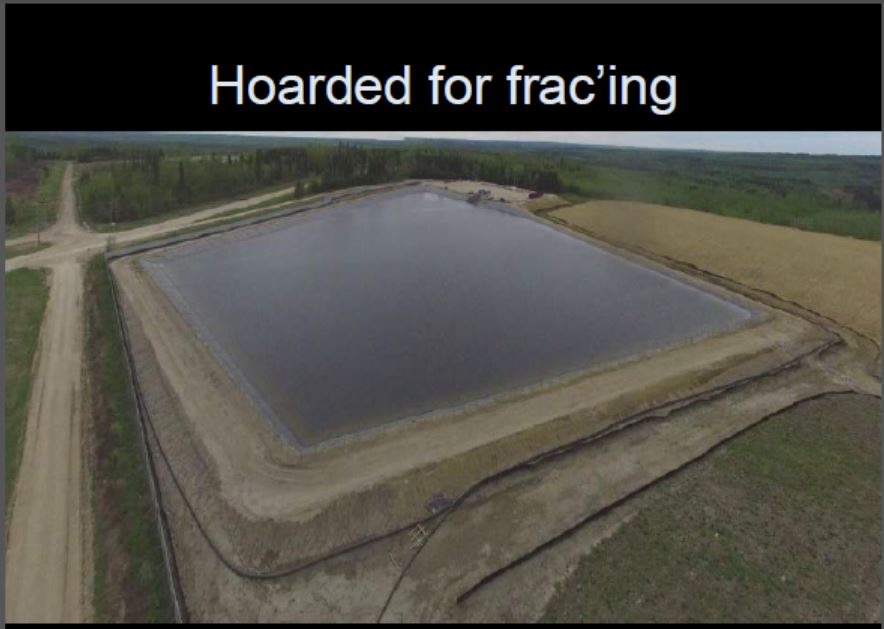
Mr. Atencio, a leader in the local Navajo Nation Chapter, is now part of the coalition of tribes and environmental organizations that in May sued New Mexico alleging that the state had failed to protect its residents from the harms of fracking.
A substantial portion of their complaint focuses on the strain that oil and gas development places on freshwater in New Mexico, one of the nation’s most water-stressed states.
“We’re facing some of the worst years of drought in the last 1,200 years,” said Julia Bernal of the Pueblo Action Alliance, an Indigenous organization that is a party to the lawsuit. Yet energy companies were building water pipelines to serve fracking sites, she said. “There are a lot of families that live in the region that don’t have access to running water.”
New Mexico said it “vigorously disagrees” with the lawsuit’s allegations and was proud of its work regulating oil and gas. Enduring Resources didn’t respond to requests for comment.
Across the country, investments like these in water for oil and gas — wells, pipelines and even water distribution companies — are extensive and spreading.
In Colorado, the energy exploration companies Anadarko and Noble Energy have invested tens of millions of dollars in freshwater pipelines and have created companies to sell and distribute water for fracking. In 2020, Chevron acquired Noble Energy, together with its water business, in a transaction worth more than $13 billion.
When Kevin Chan moved to Colorado from California last year, to a neighborhood on the banks of the Aurora Reservoir, he said he was surprised to learn that more than 150 horizontal fracked wells were planned in the region around the reservoir. The wells would potentially require a total of 3.9 billion gallons of freshwater from a local water district and other sources, according to the energy company behind the project, Denver-based Civitas.
Concerned about the water use and risk of oil spills, he formed a community group, Save the Aurora Reservoir, to oppose the plan. In moving to Colorado, “I was drawn to the proximity to the mountains, being able to go snowboarding,” Mr. Chan said. “I didn’t expect to go up against a multibillion dollar industry.”![]() Me neither, nor did I expect to lose my life long savings and 11 years of my life in the process and be betrayed by every regulator, court and even my own lawyers. And, still, I have no safe water.
Me neither, nor did I expect to lose my life long savings and 11 years of my life in the process and be betrayed by every regulator, court and even my own lawyers. And, still, I have no safe water.![]()
Rich Coolidge, a spokesman for Civitas, said several thousand feet of rock separated the Aurora reservoir from oil and gas production. He said the company was working with local water providers that sell surplus supply, but declined to give details.
Some local governments are starting to take action. In 2020, New Mexico halted sales of water supplies to oil and gas companies fracking on state land. This year, Colorado passed a bill requiring frackers to greatly increase their reuse of fracking wastewater. ![]() greatly increasing near zero is not going to save much
greatly increasing near zero is not going to save much![]() In May, Texas passed a bill designed to find more uses for fracking wastewater.
In May, Texas passed a bill designed to find more uses for fracking wastewater.![]() Make livestock, wildlife and us drink the toxic crap.
Make livestock, wildlife and us drink the toxic crap.![]()
But cleaning up that wastewater, which contains hazardous chemicals, is costly and energy-intensive. Even if frackers were able to re-use their treated wastewater for all their production, the industry estimates it would still generate hundreds of millions of gallons of excess every day. And the diversion of fracking wastewater to other uses, whether for agriculture or to mist roadways in order to keep down the dust, remains contentious because of safety concerns.
So, in states like Texas, it remains cheaper to use groundwater.
Mr. Martin, the rancher and farmer who heads the Wintergarten water district, doesn’t fault energy companies for that. He himself irrigates his cantaloupe fields using groundwater.
Still, as he contemplated a future of ever-dwindling aquifers, he struck a somber tone. “If the water goes away, the whole community goes away,” he said.
Methodology
To analyze trends in total water use, The New York Times used data from FracFocus, a registry of company disclosures of the chemicals used in fracking that is operated by the Groundwater Protection Council and the Interstate Oil and Gas Compact Commission.
The FracFocus data is self-reported, and the Times identified some inconsistencies. To clean the data, the Times excluded duplicate entries, and entries without water data, and double-checked with various researchers about best practices in using the data.
The Times also reached out to large operators that reported anomalously high values; many responded that those values were erroneous and that they would correct their filings. In an effort to mitigate the impact of outliers, the Times analyzed median water use values, which most likely underestimates fracking water use. The Times also calculated total water use using standard tallying.
To identify the biggest users of water, the Times analyzed data from 20 of the companies, including subsidiaries, that have the largest fracking well counts nationwide. After identifying the subsidiaries of major water well operators, The Times tallied water use by parent company.
The Times tallied national total water use reported to FracFocus, and compared that tally to municipal water use volumes for the state of Texas as reported in the state’s survey data for public water systems.
Texas map source: Submitted Drillers Reports (SDR) Database, Texas Water Development Board. FracFocus chemical disclosure database as of Aug. 1, 2023. Aquifer estimates from GebreEgziabher, Jasechko & Perrone, Nature Communications (2022). Water Use Survey Data for Public Water Systems, Texas Water Development Board (2020).

Refer also to:
2023: Frac Canada Dry!
2009: A Primer for Understanding Canadian Shale Gas – Energy Briefing Note by Canada’s by National Energy Board (now Canadian Energy Regulator), ISSN 1917-506X
… Frac water often contains chemical additives to help carry the proppant and may become enriched in salts after being injected into shale formations. Therefore, frac water that is recovered during natural gas production must be either treated or disposed of in a safe manner. …
Flow-back water is infrequently reused in other fracs because of the potential for corrosion or scaling, where the dissolved salts may precipitate out of the water and clog parts of the well or the formation. …
